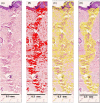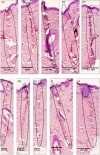An evaluation of electrocoagulation and thermal diffusion following radiofrequency microneedling using an in vivo porcine skin model
- PMID: 32846042
- PMCID: PMC8048620
- DOI: 10.1111/jocd.13690
An evaluation of electrocoagulation and thermal diffusion following radiofrequency microneedling using an in vivo porcine skin model
Abstract
Background: Few studies exist that examined the role of radiofrequency microneedling (RFMN) in skin electrocoagulation. This research utilized a porcine model to understand bipolar dermal delivery from an RFMN device.
Aims: The objective of this study was to elucidate and compare the dermal thermal effects of a RFMN device producing 1 and 2 MHz signal amplitudes, with respective voltage and current gradients, utilizing noninsulated and insulated needles by examining the histologic effects on porcine skin.
Methods: Two separate animal studies were conducted to evaluate the electrocoagulation and thermal diffusion effects using the RFMN device. The electrocoagulation effects were assessed histologically using hematoxylin and eosin (H&E) staining, and heating effects were assessed through thermal imaging.
Results: Histology results of the thermal injury induced by insulated needles demonstrated that 2 MHz resulted in a narrow and concentrated coagulation zone as compared to 1 MHz. Further, the 1 MHz insulated needle resulted in ovular shaped tissue coagulation as compared to 2 MHz tissue coagulation that was columnar. Finally, full thermal diffusion occurs seconds after the set RF conduction time.
Conclusion: The findings showed that 1 MHz insulated needle produces larger coagulations with an increase in power level, the 1 MHz noninsulated array was comparable to the 2 MHz insulated array with similar histologic features, and heat dissipates seconds after the set conduction time.
Keywords: dermal heating; electrocoagulation; microneedling; radiofrequency; skin tightening.
© 2020 Aesthetics Biomedical, Inc. Journal of Cosmetic Dermatology published by Wiley Periodicals LLC.
Conflict of interest statement
Shaun Wootten, BSE, and Lawrence Rheins, PhD, work for Aesthetics Biomedical, Inc Zoe Diana Draelos, MD, has served as a researcher and consultant for Aesthetics Biomedical, Inc.
Figures






References
-
- Cho SI, Chung BY, Choi MG, et al. Evaluation of the clinical efficacy of fractional radiofrequency microneedle treatment in acne scars and large facial pores. Dermatol Surg. 2012;38(7 Pt 1):1017‐1024. - PubMed
-
- Peterson JD, Palm MD, Kiripolsky MG, et al. Evaluation of the effect of fractional laser with radiofrequency and fractionated radiofrequency on the improvement of acne scars. Dermatol Surg. 2011;37(9):1260‐1267. - PubMed
-
- Man J, Goldberg DJ. Safety and efficacy of fractional bipolar radiofrequency treatment in Fitzpatrick skin types V‐VI. J Cosmet Laser Ther. 2012;87(6):179‐183. - PubMed
-
- Lee SJ, Goo JW, Shin J, et al. Use of fractionated microneedle radiofrequency for the treatment of inflammatory acne vulgaris in 18 Korean patients. Dermatol Surg. 2012;38(3):400‐405. - PubMed
-
- Van NB, Alster TS. Laser treatment of dark skin: a review and update. J Drugs Dermatol. 2009;8(9):821‐827. - PubMed
MeSH terms
Grants and funding
LinkOut - more resources
Full Text Sources
Other Literature Sources

